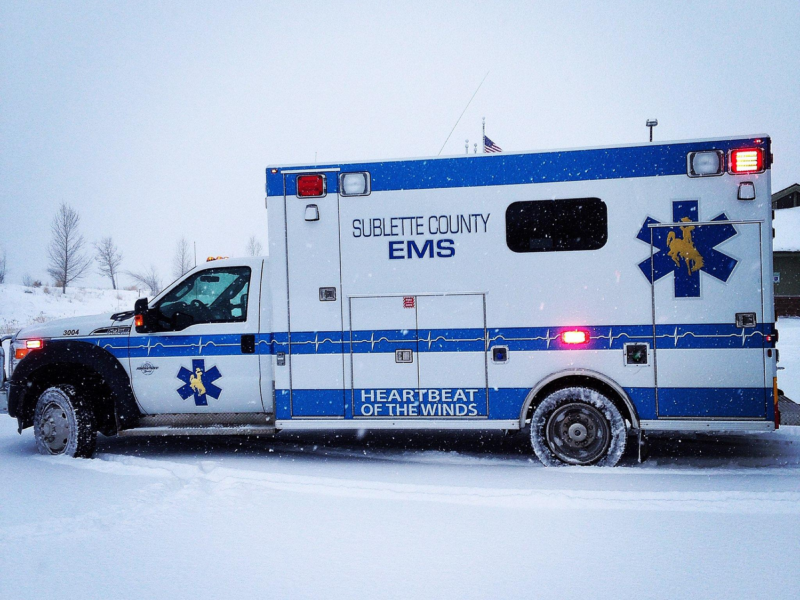Lives on the Line as EMS Systems Struggle
Emergency responders face a myriad of challenges across the state, putting residents’ lives at risk
- Published In: Other News & Features
- Last Updated: Oct 11, 2022

Pictured above is a Sublette County Emergency Medical Services (EMS) vehicle. EMS agencies throughout Wyoming are facing a myriad of issues, including rising costs of operation and dwindling staff. (Courtesy photo from Luke Sypherd)
By Melissa Thomasma and Shen Wu Tan
Special to the Wyoming Truth
Strokes and heart attacks rank as the top 10 causes of death in Wyoming. These medical emergencies can strike unexpectedly, explains the Centers for Disease Control (CDC), and the data demonstrates that rapid medical care can be the difference between life and death. More often than not, the first line of medical intervention lies in the hands of emergency responders: EMTs and paramedics.
If these experts can’t reach you in time, your chances of survival crash. Your brain, heart and other organs suffer increasingly irreparable damage with every minute that ticks by.
So what if there are not enough Emergency Medical Services (EMS) staff to respond to calls quickly?
Wyoming’s EMS system has faced significant challenges for years: dwindling staff, increasing call volumes and rising operational costs. Some agencies have shuttered entirely. The results for residents could be tremendously costly, if not deadly.
But with the system now at a crisis point, state officials are working to find solutions. Last week, the Wyoming Department of Health opened up grant applications for regionalization pilot programs that will run through 2026 for the five trauma regions across the state and for “investigating alternative options for emergency medical services that improve access and reduce costs,” according to the funding announcement. The application period will stay open for 45 days.
The state legislature approved $10 million to develop these regional pilot programs earlier this year. It also allocated $5 million in stabilization funding that will support retention payments and recruitment activities for both paid and volunteer frontline EMS workers, said Kim Deti, spokesperson for the Wyoming Department of Health.
“One of the key components necessary for Wyoming to have a robust healthcare system is to ensure our first responder system is viable and sustainable,” Gov. Mark Gordon said in a statement regarding the EMS funding. “It is essential that emergency services be ready to respond when and where the need arises, whether that be in our most rural areas or in our larger communities.”
Short on staff, long on response times
Wyoming EMS responded to approximately 89,000 requests for service in 2021, data from the state health department shows. Currently, 48 agencies staff 78 stations throughout Wyoming. These services are operated by hospitals, fire departments, nonprofit groups and corporations, so funding mechanisms are diverse and often fragmented.
Since 2005, the health department noted, 10 EMS agencies across Wyoming closed entirely; five of them in 2021. All 10 were in rural areas. On top of that, the number of calls for service increased by around 27% from 2016 to 2021.
“We face fatigue and burnout from the increasing workload without the increase in personnel,” Luke Sypherd, president of the Wyoming EMS Association, told the Wyoming Truth. “We see EMS providers facing mental health challenges; they see a tremendous amount of illness, traumatic injuries, death, abuse and much more. We face a lack of support from our communities. Everyone will agree that EMS is essential, but to this point, we have not seen action associated with that statement.”
Historically, departments and agencies nationwide have relied on volunteers to bolster their ranks. The number of volunteers, however, has declined since the late 1980s.
“Our office is hearing that the main challenges are funding for operations and workforce shortages, primarily a volunteer workforce that is going away,” said Jen Davis, senior policy advisor on health and human services for Gov. Gordon. “If EMS providers are unable to sustain operations, we could be looking at increased response times as responders may need to travel further. We could also see more utilization of air medical, which is higher cost compared to ground services.”
She added, “The system is very fragile right now.”
The price tag for reliable service
Wyoming’s landscape and low population create challenges for accessing medical care, particularly in rural communities. Meanwhile, sustainable funding for EMS services has become an increasingly difficult and complex matter, said Deti, the state health department spokesperson.
Seventy percent of calls are emergency response through 911 — as opposed to non-emergent transfers or other medical transports — but roughly 35% of 911 calls are not reimbursed. “Medicare and Medicaid-covered patients make up the majority of EMS calls, and they reimburse below the actual cost to operate,” added Sypherd. “There are also many people who just don’t pay their bills, which leaves EMS agencies with even less money.”
Without funding, services simply cannot operate.
From a financial perspective, the costs of maintaining vehicles, equipment and staff are becoming overwhelming for agencies. A 2021 study calculated the average cost nationwide for a Basic Life Support (BLS) ambulance to operate for one year, 24 hours a day, at $507,474. Equipment costs hovered around $70,000, and a full BLS staff cost $456,396. A BLS staff is composed of EMTs, and while their training is significant, they lack the intervention abilities of paramedics or other Advanced Life Support (ALS) providers.
Maintaining an ALS staff on an ambulance around the clock carries a price tag of $1.1 million.
Searching for solutions
In an effort to solve the EMS crisis, state officials conducted six listening sessions with providers for the five trauma regions: Gillette, Casper, Cheyenne, Evanston and Thermopolis.
An Oct. 3 report listed some proposed solutions, including a statute to allow the creation of EMS districts, additional funding for initial and ongoing education for EMS staff and investment in a 911 “nurse navigator” to screen for medically unnecessary calls to the emergency phone number.
Sypherd suggested passing a law to make EMS a mandatory service and introducing a tax-based subsidy to bolster financial resources statewide. He is hopeful that the funding and pilot programs will help agencies regain stability and create sustainability.
“How each entity will use those funds and how the distributions will occur is still undecided,” Sypherd said. “The regional pilot programs aim to create solutions to the issues we face at a regional level.”
Ultimately, Sypherd sees increased collaboration as essential to developing more stable EMS systems.
“This may help with recruiting efforts and reducing cost to provide care,” he said. “We have seen several agencies consolidate to form larger locally-owned and operated entities, specifically hospitals, that are able to provide care at a lower cost. Simple scale of operation economics. The key phrase is locally-owned and operated.”













